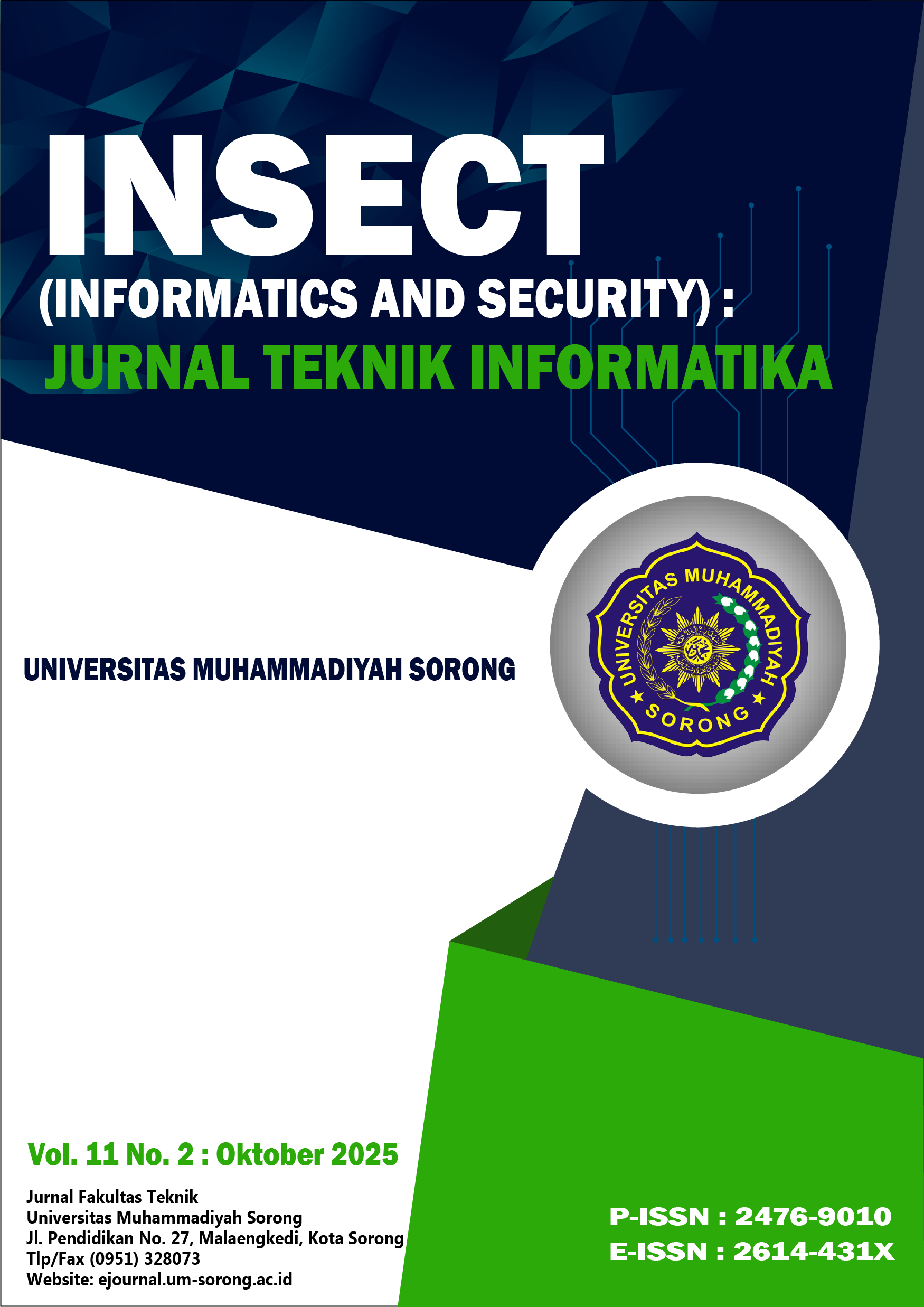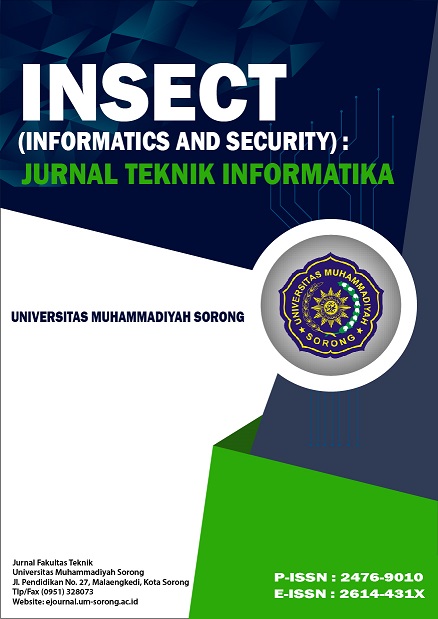Implementation of the Performance-Asset Management Method in the School Asset Management Information System (SIMAS)
DOI:
https://doi.org/10.33506/insect.v11i2.4974Keywords:
Information Systems, Asset Management, Performance-Based Management, Waterfall, SIMASAbstract
School assets play a vital role in supporting learning activities and administrative operations, yet many schools still manage assets manually, leading to data inaccuracy, difficulty in monitoring conditions, and inefficiency in reporting. This study aims to design and implement a School Asset Management Information System (SIMAS) using the Performance-Based Asset Management (PBAM) method to address these challenges. The research applies a qualitative approach through observation, interviews, and literature study to identify asset management problems in schools. The system was developed using the Waterfall model, consisting of analysis, design, implementation, testing, and documentation. PBAM principles were integrated to support planning, maintenance, monitoring, and continuous improvement of asset utilization. The results demonstrate that SIMAS provides structured asset registration, facilitates real-time monitoring, generates performance-based reports, and issues automatic notifications for urgent maintenance. This contributes to improving decision-making, enhancing efficiency in school asset management, and ensuring long-term sustainability of educational resources. The findings highlight that the application of PBAM in the education sector, particularly in schools, provides a novel contribution compared to previous studies that mainly focused on asset recording and depreciation methods
References
[1] A. Siwi, F. Utami, and M. Tabrani, “Implementasi Metode Waterfall dalam Sistem Informasi Inventarisasi Barang Berbasis Web pada Kecamatan Johar Baru,” J. Inf. Manag., vol. 9, no. 2, pp. 111–120, 2024.
[2] Muhammad Iqbal, “PERAN PENDIDIKAN VOKASI DALAM PENGEMBANGAN EKONOMI ISLAM,” Malia J. Ekon. Islam, vol. 13, no. 2, pp. 193–212, 2022, doi: 10.35891/ml.v13i2.2965.
[3] A. Aristo, J. Sinlae, R. S. Septarini, S. D. Saraswati, and I. Nanda, “Penerapan Metode Rapid Application Development (RAD) Pada Pengembangan Sistem Informasi Aset Desa,” J. Ilm. Sist. Inf. Akunt., vol. 4, no. 1, pp. 35–44, 2024.
[4] N. Hamamoto, K. Ogawa, H. Ueda, M. Furukawa, M. Nakamura, and K. Yamaji, “Analysis of Activity Logs of GakuNin LMS in the Use of the Information Security Course at Gunma University,” Procedia Comput. Sci., vol. 225, pp. 2932–2941, 2023, doi: 10.1016/j.procs.2023.10.286.
[5] T. Lääveri, P. Metsäniemi, T. Tuovinen, S. Vainiomäki, and J. Reponen, “Healthcare information system support for leadership and management: Experiences of Finnish physician leaders by specialty from three cross-sectional surveys in 2014, 2017, and 2021,” Int. J. Med. Inform., vol. 196, no. July 2024, 2025, doi: 10.1016/j.ijmedinf.2025.105814.
[6] K. Hafidz, M. D. Irawan, and H. D. Nawar, “Sistem Penginputan Data Bahan Pokok pada Pasar Tradisional Sumatera Utara Berbasis Website di Disperindag Sumut,” sudo J. Tek. Inform., vol. 1, no. 3, pp. 98–107, 2022, doi: 10.56211/sudo.v1i3.27.
[7] N. T. Baran, K. M. V. C. Gumonan, A. L. M. Martinez, and M. L. E. Lacsa, “Designing and Implementing e-School Systems: An Information Systems Approach to School Management of a Community College in Northern Mindanao, Philippines,” Int. J. Comput. Sci. Res., vol. 6, pp. 792–808, 2022, doi: 10.25147/ijcsr.2017.001.1.74.
[8] S. Kaindaneh, J. de Kadt, S. Bechange, E. Jolley, N. Smart, and E. Schmidt, “An assessment of the Education Management Information System in Sierra Leone and potential for enhanced disability inclusiveness,” Int. J. Educ. Res. Open, vol. 7, no. June, p. 100399, 2024, doi: 10.1016/j.ijedro.2024.100399.
[9] R. Chiosa, M. S. Piscitelli, M. Pritoni, and A. Capozzoli, “A portable application framework for energy management and information systems (EMIS) solutions using Brick semantic schema,” Energy Build., vol. 323, no. September, p. 114802, 2024, doi: 10.1016/j.enbuild.2024.114802.
[10] Corry Lea Taryono, Saludin Muis, and Andri Irawan, “Perancangan Sistem Informasi Manajemen Aset Kampus Stmik Kuwera Berbasis Web Menggunakan Metode Simple Additive Weighting (SAW) Dan Straight Line,” J. Sist. Inf. dan Teknol., vol. 1, no. 4, pp. 1–12, 2024, doi: 10.56995/sintek.v1i4.63.
[11] P. Lu, “Design of Information Management System Based on Random Leapfrog Band Selection Algorithm,” Procedia Comput. Sci., vol. 243, pp. 92–99, 2024, doi: 10.1016/j.procs.2024.09.013.
[12] E. Locatelli and L. Proietto, “Analysis of the information flux model among all the actors involved in the use of a Bridge Management System according to Italian Guidelines: The BMS as a collaborative workplace,” Procedia Struct. Integr., vol. 62, pp. 209–216, 2024, doi: 10.1016/j.prostr.2024.09.035.
[13] F. A. Barus, “Pemanfaatan Media Google Classroom pada Mata Pelajaran Bahasa Indonesia di SMA PAB 3 Medan,” J. Rev. Pendidik. dan Pengajaran , vol. 7, no. 1, pp. 655–660, 2024.
[14] R. N. J. M. N et al., “Analisis Manajemen Risiko Teknologi Informasi dengan Metode FMEA dan Kontrol ISO 27001 : 2013 Pada Perusahaan Kontruksi Kapal,” J. Ilm. Media Sisfo, vol. 18, no. 2, pp. 166–176, 2024, doi: https://doi.org/10.33998/mediasisfo.2024.18.2.1795.
[15] W. Hasibuan, M. D. Irawan, and R. I. Pulungan, “Sistem Informasi Pengaduan Jaringan Internet pada Dinas Komunikasi dan Informatika Padang Lawas Berbasis Web,” Blend Sains J. Tek., vol. 1, no. 1, pp. 21–30, 2022, doi: 10.56211/blendsains.v1i1.65.
[16] S. S. Chen, Y. C. Liu, and I. J. Chen, “Long-run stock performance and its determinants for asset buyers,” J. Bus. Financ. Account., vol. 41, no. 5–6, pp. 685–716, 2023, doi: 10.1111/jbfa.12065.
[17] M. C. Carnero, A. Martínez-Corral, and J. Cárcel-Carrasco, “Fuzzy multicriteria evaluation and trends of asset management performance: A case study of Spanish buildings,” Case Stud. Constr. Mater., vol. 19, no. July, 2023, doi: 10.1016/j.cscm.2023.e02660.
[18] I. Febiana and M. D. Irawan, “Perancangan Aplikasi Input Laporan Data Single Line Diagram Unit Layanan Pengadaan PLN SUMUT Design of Data Input Report Single Line Diagram-Unit Procurement Services for North Sumatera PLN,” J. Ilmu Komput. dan Sist. Inf., vol. 2, no. 2, pp. 234–246, 2022, [Online]. Available: https://jurnal.unity-academy.sch.id/index.php/jirsi/index%0Ahttp://creativecommons.org/licenses/by-sa/4.0/
[19] J. Liu, “Design and Application of Human resource management system Based on Data Mining Technology,” Procedia Comput. Sci., vol. 228, pp. 241–252, 2023, doi: 10.1016/j.procs.2023.11.028.
[20] S. Matarneh, F. Elghaish, F. P. Rahimian, N. Dawood, and D. Edwards, “Automated and interconnected facility management system: An open IFC cloud-based BIM solution,” Autom. Constr., vol. 143, no. September, p. 104569, 2022, doi: 10.1016/j.autcon.2022.104569.
[22] S. Ochella, M. Shafiee, and C. Sansom, “An RUL-informed approach for life extension of high-value assets,” Comput. Ind. Eng., vol. 171, no. June, p. 108332, 2022, doi: 10.1016/j.cie.2022.108332.
[21] A. M. El‐Maissi, S. A. Argyroudis, M. M. Kassem, and F. Mohamed Nazri, “Development of Intrinsic Seismic Vulnerability Index (ISVI) for assessing roadway system and its assets framework,” MethodsX, vol. 9, p. 101818, 2022, doi: 10.1016/j.mex.2022.101818.
[22] R. C. Ilumin and A. W. C. Oreta, “A Post-Disaster Functional Asset Value Index for School Buildings,” Procedia Eng., vol. 212, no. 2017, pp. 230–237, 2018, doi: 10.1016/j.proeng.2018.01.030.
[23] C. Simões, M. G. Matos, G. Tomé, M. Ferreira, and H. Chaínho, “School satisfaction and academic achievement: The effect of school and internal assets as moderators of this relation in adolescents with special needs,” Procedia - Soc. Behav. Sci., vol. 9, pp. 1177–1181, 2010, doi: 10.1016/j.sbspro.2010.12.303.
[24] T. Wiendhyra, N. H. Harani, R. Habibi, and R. M. Awangga, “Sistem Informasi Manajemen Aset Menggunakan Metode Garis Lurus Dan Multi Attribute Utility Theory (Studi Kasus: Sman 3 Cimahi),” J. Teknol. Univ. Muhammadiyah Jakarta, vol. 14, no. 2, pp. 214–220, 2022.
[25] R. Adolph, “Development of risk-informed, performance-based asset management in mining,” Int. J. Mining, Reclam. Environ., vol. 22, no. 2, pp. 1–23, 2008, [Online]. Available: https://doi.org/10.1080/17480930701562176
[26] J. W. Hall, J. W. le Masurier, E. A. Baker-Langman, & John P. Davis, and C. A. Taylor, “A decision-support methodology for performance-based asset management,” Civ. Eng. Environ. Syst., vol. Volume 21, no. 1, pp. 51–75, 2010, doi: https://doi.org/10.1080/1028660031000135086.
[27] Febryantahanuji, Z. Mustofa, and A. A. Kuncoro, “Sistem Informasi Administrasi Pembayaran Spp Pada Sma,” J. Publ. Tek. Inform., vol. 1, no. 2, pp. 90–98, 2022, doi: 10.55606/jupti.v1i2.465.
[38] M. Mawaddah and J. Devitra, “Sistem Informasi Manajemen Proyek Konstruksi Pada CV. Lumbung Agroendo,” J. Manaj. Sist. Inf., vol. 8, no. 3, pp. 520–529, 2023, doi: 10.33998/jurnalmsi.2023.8.3.1487.
[29] F. Ferliadi, “Sistem Informasi Manajemen Aset Dan Keuangan,” J. Ilm. Sist. Inf. Akunt., vol. 1, no. 2, pp. 7–15, 2022, doi: 10.33365/jimasia.v1i2.1103.
[30] A. Agustina and M. A. K. Hutagalung, “Pengaruh Kualitas Pelayanan Produk Pembiayaan Kendaraan Dan Fasilitas Terhadap Kepuasan Nasabah Pada PT. Bank Sumut Syariah Kcpsy Kota Baru Medan Marelan,” J. Al-Qasd …, vol. 3, no. 2, pp. 136–146, 2023, [Online]. Available: http://e-journal.potensi-utama.ac.id/ojs/index.php/ALQASD/article/view/2078%0Ahttp://e-journal.potensi-utama.ac.id/ojs/index.php/AL-QASD/article/download/2078/2258
[31] R. M. I. B. D. A. Samsudin, “Analisis Statistik Penggunaan Portal Akademik ,” JATI (Jurnal Mhs. Tek. Inform., vol. 9, no. 4, pp. 6709–6715, 2025, [Online]. Available: https://ejournal.itn.ac.id/index.php/jati/article/view/13888
[32] S. Samsudin and M. F. Alyuda, “Perancangan Sistem Informasi Pendaftaran PKL Berbasis Web Pada Kantor Regional VI Badan Kepegawaian Negara Medan,” J. Ilm. Sist. Inf. dan Tek. Inform., vol. 7, no. 2, pp. 195–205, 2024, doi: 10.57093/jisti.v7i2.224.
[33] S. Samsudin and A. A. M. Pramesti, “Rancang Bangun Sistem Informasi Manajemen Aset Pada BPJS Ketenagakerjaan Tanjung Morawa,” Jutisi J. Ilm. Tek. Inform. dan Sist. Inf., vol. 12, no. 2, p. 456, 2023, doi: 10.35889/jutisi.v12i2.1120.
[34] Y. K. Rizal and S. Samsudin, “Analisis Pengembangan Sistem Informasi Manajemen Fiber To The Home Menggunakan Metode Pieces Pada PT. XYZ,” Informatika, vol. 12, no. 3, pp. 644–654, 2025, doi: 10.36987/informatika.v12i3.6906.
[35] V. R. Muhammad Rizki Fadillah, Samsudin, “Sistem Informasi Manajemen Magang dengan Metode System Integration di Biro Kesejahteraan Rakyat Setdaprovsu,” Informatika, vol. 12, no. 3, pp. 626–635, 2025, [Online]. Available: https://m.entertain.naver.com/home/article/108/0003338187
[36] D. Almansah and S. Samsudin, “Rancang Bangun Sistem Informasi Manajemen Masjid Pada Masjid Al-Falah Menggunakan Metode Activity-Based Budgeting,” Jutisi J. Ilm. Tek. Inform. dan Sist. Inf., vol. 13, no. 3, 2025, doi: 10.35889/jutisi.v13i3.2420E. A. Shams and A. Rizaner, “A novel support vector machine based intrusion detection system for mobile ad hoc networks,” Wirel. Networks, vol. 24, no. 5, pp. 1821–1829, 2018, doi: 10.1007/s11276-016-1439-0.

Downloads
Published
How to Cite
Issue
Section
License
Copyright (c) 2025 Nola Putri Ritonga, Muhammad Dedi Irawan

This work is licensed under a Creative Commons Attribution-ShareAlike 4.0 International License.







